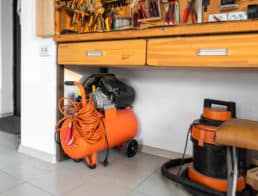An air compressor is a useful and versatile tool. It can be used for tasks ranging from inflating car tires to powering air tools like nail guns and drills. In this article, we’ll explain more about how air compressors work and share some tips to help you use them safely and effectively.
What Is an Air Compressor?
An air compressor is a device that compresses and pressurizes air. 1 The compressed air is then released and used for various applications. These include inflating tires and other objects, powering air tools like nail guns or sanders, cleaning up dirt and debris, and much more. The versatile nature of air compressors makes them a popular addition to garages, worksites, and homes.
How Do Air Compressors Work?
There are several different types of air compressors, but they all work in a similar fashion. The first step is to draw air from the surrounding environment into the compressor pump via an intake valve. This air then moves through a series of tubes and chambers that progressively pressurize it until it reaches maximum capacity before being released out of the outlet valve as compressed air.

Image courtesy of Pixabay
What Are the Advantages of an Air Compressor?
There are many advantages to owning an air compressor. First, they’re relatively inexpensive and simple to use. They’re also portable and easy to store, making it possible to use one at multiple locations if necessary. Another advantage is that they’re incredibly versatile, allowing you to perform a wide range of tasks. Finally, air compressors are reliable and efficient, making them a good investment for your home or garage.
What Kind of Air Compressor Do I Need for Home Use?
This will depend on the types of tasks you plan to use it for. If your main goal is inflating car tires, a small compressor that uses an electric motor may be sufficient. On the other hand, if you’re looking for something with more power and performance options, then a gas-powered model or larger compressor is likely a better choice. Please refer to our guide for more information about choosing the right size air compressor.

Image courtesy of Pixabay
A Step-by-Step Guide to Using an Air Compressor
Using an air compressor is not complicated, but it’s important to follow safety guidelines and instructions when you operate one. Follow this step-by-step guide to ensure you use an air compressor safely and effectively.
- Read and familiarize yourself with the air compressor’s safety instructions.
- Always wear suitable protective clothing like safety goggles, gloves, and closed-toe shoes or boots. 2
- Position the air compressor on a flat, stable work surface. Next, make sure the power switch is turned off and connect the power cord to a grounded electrical outlet.
- Prepare the environment. Make sure that the area around the air compressor is clear and free of flammable materials, chemicals, or other items that may be hazardous.
- Check the oil level. Make sure that the air compressor is properly lubricated and there’s enough oil (if applicable) for optimal performance.
- Make sure the drain valve is closed by tightening it with an adjustable wrench.
- Turn the power switch on and let the air compressor run for a few minutes. Keep an eye on the air gauge and make sure the compressor switches off automatically when the air pressure reaches maximum capacity. Generally, this is around 100-115 PSI.
- When using the compressor with an air tool, adjust the air control valve to match the maximum PSI of the air tool you’ll be using.
- Connect the air hose to the compressor and make sure you have enough length to reach the desired work area. You may need to wrap the threaded end of the hose with thread seal tape. Please refer to the manufacturer’s instructions for guidance.
- Use the quick-connect fitting on the hose to connect an air tool such as a drill, nail gun, or impact wrench if required.
- Now that you’re set up and ready, it’s time to begin your work. As you use the air compressor, the pressure will drop and refill until it reaches maximum capacity again.
- If you change air tools, remember to adjust the air control valve to match the maximum PSI of the new tool.
- After you’ve finished working, turn the compressor off and unplug the power cord.
- Open the drain tank valve to let out condensation from the unit. Please refer to the manufacturer’s instructions for further guidance.
- Disconnect the hose and store the air compressor safely indoors for the next time you need it. Remember that they’re heavy and can cause damage or injury if you drop them accidentally.
If you’re looking for help using an air compressor, the steps in this article will give you a good place to start. Always remember to exercise caution when using an air compressor and follow the safety instructions provided by the manufacturer. Looking for an efficient and reliable air compressor that can perform a variety of tasks? Check out our list of the best air compressors for a home garage.
Article Sources
Home Life Daily uses only high-quality sources, including peer-reviewed studies, to support the facts within our articles. Read our editorial process to learn more about how we fact-check and keep our content accurate, reliable, and trustworthy.
- How Air Compressors Work: An Animated Guide. Bigrentz.com. Published January 3, 2020. Accessed September 30, 2021.
- How to Use an Air Compressor. Wikihow.com. Updated March 29, 2019. Accessed September 30, 2021.










